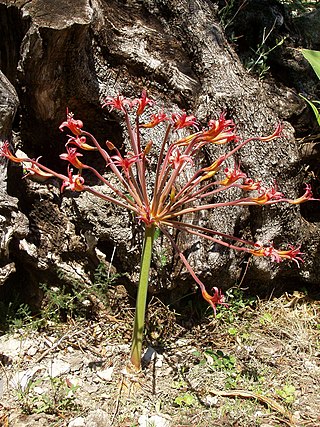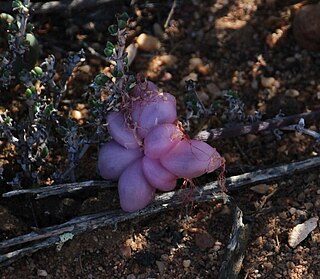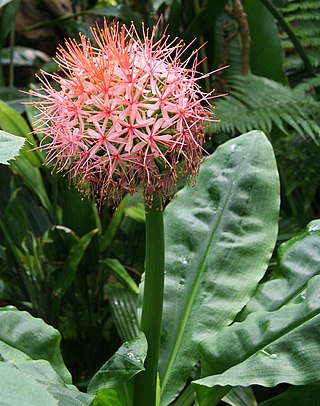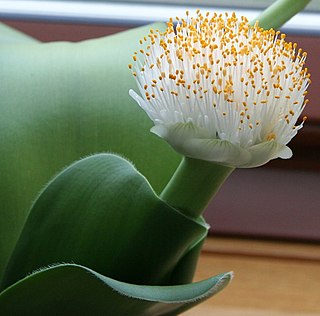
Amaryllis is the only genus in the subtribe Amaryllidinae. It is a small genus of flowering bulbs, with two species. The better known of the two, Amaryllis belladonna, is a native of the Western Cape region of South Africa, particularly the rocky southwest area between the Olifants River Valley and Knysna.

Brunsvigia is a genus of African flowering plants in the family Amaryllidaceae, subfamily Amaryllidoideae. It contains about 20 species native to southeastern and southern Africa from Tanzania to the Cape Provinces of South Africa.

Haemanthus albiflos is a species of flowering plant in the family Amaryllidaceae, native to the coast and mountains of South Africa. It is sometimes given the English name paintbrush, not to be confused with Castilleja species which also have this name. It is an evergreen bulbous perennial geophyte, prized horticulturally for its unusual appearance and extreme tolerance of neglect. H. albiflos is the only Haemanthus species found in both winter and summer rainfall regions, and has a mainly coastal distribution from the southern Cape through the Eastern Cape to KwaZulu-Natal, showing a preference for cool, shady spots.

Haemanthus amarylloides Jacq. is an endemic South African bulbous plant. It was first described in 1804 by Nikolaus Joseph von Jacquin from specimens sent to the Schönbrunn Palace gardens by the collectors Boos and Scholl. Franz Boos was an Austrian botanist who, with Franz Bredemeyer, made up Emperor Joseph II's gardening team. Boos and his assistant Georg Scholl, were collecting Cape plants for the imperial gardens. These collections were transported to Vienna by Nicolas Thomas Baudin, who had been carefully briefed by Boos on the techniques used for keeping plants and animals alive on long ship voyages.

Haemanthus coccineus, the blood flower, blood lily or paintbrush lily, is a species of flowering plant in the amaryllis family Amaryllidaceae, native to Southern Africa. Growing to 35 cm (14 in) tall and wide, it is a bulbous perennial with short brown stems surmounted by red flowers, the flowers appearing in spring and summer, before the strap-shaped leaves.

Haemanthus canaliculatus is a South African bulbous geophyte in the genus Haemanthus. It is found only over a small area in the Western Cape between Kleinmond and Rooiels, growing at about 30 m above sea level with an annual rainfall of 650 mm. Its favoured habitat is under dense bush in seasonally inundated shallow depressions, where it usually occurs in clumps. The leaf-bases or tunics of the bulb are thick, fleshy, distichous and loosely separated as in the spread fingers on a hand cf. Haemanthus pubescens. Leaves are from one to four, red-barred at the base, held in a sub-erect position and appear after the flowers. The peduncle is up to 200 mm long with 5-7 spathe valves that are bright red to pink in colour. Fruits are about 20 mm in diameter and reddish. Seeds are shiny and deep red.

Strumaria is a genus of African plants in Amaryllis family, subfamily Amaryllidoideae. The genus is known in nature only from South Africa, Lesotho and Namibia. Almost all species flower in the autumn and are cultivated as ornamental bulbous plants.

Haemanthus crispus is a South African bulbous geophyte in the genus Haemanthus and occurring in Namaqualand which lies in the winter rainfall region. It is a common species and is found from Steinkopf to the Olifants River, growing from the coastal flats eastwards onto the stony, lower slopes of the first terrace, usually in heavy soils and often in the shade of low succulent shrubs.

Haemanthus dasyphyllus is an endemic South African bulbous geophyte, one of about 20 species in the genus Haemanthus, and is found near Loeriesfontein in Namaqualand.

Haemanthus pubescens is an endemic South African bulbous geophyte in the genus Haemanthus.

Scadoxus puniceus, commonly known as the paintbrush lily, is a species of bulbous plant. It is native to much of southern and eastern Africa: Ethiopia, Sudan, Tanzania, Malawi, Mozambique, Zambia, Zimbabwe, Botswana, Eswatini (Swaziland), and South Africa. Scadoxus puniceus can be found in cool, shady habitat such as ravines and forests, where it is often found in moist leaf litter. Other common names include snake lily, royal paintbrush, King-of-Candida, African blood lily (English), rooikwas (Afrikaans), isisphompho, and umgola (Zulu). There are nine species of Scadoxus of which three, S. puniceus, S. multiflorus and S.membranaceus, occur in South Africa.

Scadoxus is a genus of African and Arabian plants in the Amaryllis family, subfamily Amaryllidoideae. The English names blood lily or blood flower are used for some of the species. The genus has close affinities with Haemanthus. Species of Scadoxus are grown as ornamental plants for their brilliantly coloured flowers, either in containers or in the ground in frost-free climates. Although some species have been used in traditional medicine, they contain poisonous alkaloids.
Paintbrush lily is a common name for several plants and may refer to:

Scadoxus multiflorus is a bulbous plant native to most of sub-Saharan Africa from Senegal to Somalia to South Africa. It is also native to Arabian Peninsula and to the Seychelles. It is naturalized in Mexico and in the Chagos Archipelago.It is also found in Indian peninsula. It is grown as an ornamental plant for its brilliantly coloured flowers, either in containers or in the ground in where the climate is suitable. There are three recognized subspecies. Strongly toxic like other Scadoxus species, it has been used as a component of arrow poisons and fishing poisons, as well as in traditional medicine. Common names, some of which are used for other species, include blood lily, ball lily, fireball lily, blood flower, Katherine-wheel, oxtongue lily, poison root and powderpuff lily.

Scadoxus cinnabarinus is a herbaceous plant from tropical rainforest in Africa. It is native to Western and Central Africa from Sierra Leone in the far west to Angola in the south. It has been reported from Ghana, Côte d'Ivoire, Nigeria, Niger, Sierra Leone, Central African Republic, Cameroon, Congo, Equatorial Guinea, Gabon, São Tomé, Zaire, Uganda, and Angola.

Scadoxus membranaceus is a flowering plant in the Amaryllidaceae family. It is a bulbous plant from South Africa. The smallest of the species of Scadoxus, it is sometimes cultivated as an ornamental plant where a minimum temperature of 5 °C (41 °F) can be maintained.
Scadoxus pseudocaulus is a herbaceous plant native to Nigeria, Equatorial Guinea, Cameroon and Gabon. Similar in many respects to Scadoxus cinnabarinus, it is cultivated as an ornamental plant but has proved reluctant to flower.

Haemantheae are a tribe of subfamily Amaryllidoideae. They are herbaceous monocot perennial flowering plants with a predominantly African distribution. Three subtribes are proposed and six genera including the type genus, Haemanthus, are included. They are characterised by the presence of baccate (berry) fruit.

Haemanthinae is a small subtribe of Haemantheae, and therefore within the African clades of Amaryllidoideae. It consists of two genera, Haemanthus, and Scadoxus.

Dierdré "Dee" Anne Snijman is a South African botanist and plant taxonomist who is notable for studying and writing extensively on bulbs. She has described over 120 species and has written comprehensive works on South African flora. She received the 1997 Herbert Medal from the International Bulb Society for her research on Amaryllis.
































